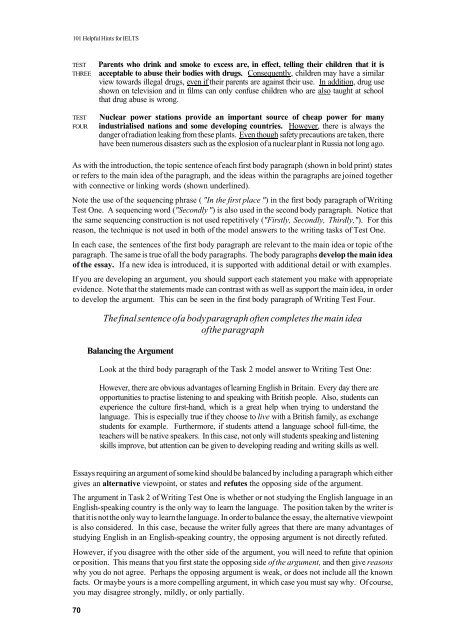You also want an ePaper? Increase the reach of your titles
YUMPU automatically turns print PDFs into web optimized ePapers that Google loves.
101 Helpful <strong>Hints</strong> <strong>for</strong> <strong>IELTS</strong><br />
TEST Parents who drink and smoke to excess are, in effect, telling their children that it is<br />
THREE acceptable to abuse their bodies with drugs. Consequently, children may have a similar<br />
view towards illegal drugs, even if their parents are against their use. In addition, drug use<br />
shown on television and in films can only confuse children who are also taught at school<br />
that drug abuse is wrong.<br />
TEST<br />
FOUR<br />
Nuclear power stations provide an important source of cheap power <strong>for</strong> many<br />
industrialised nations and some developing countries. However, there is always the<br />
danger of radiation leaking from these plants. Even though safety precautions are taken, there<br />
have been numerous disasters such as the explosion of a nuclear plant in Russia not long ago.<br />
As with the introduction, the topic sentence of each first body paragraph (shown in bold print) states<br />
or refers to the main idea of the paragraph, and the ideas within the paragraphs are joined together<br />
with connective or linking words (shown underlined).<br />
Note the use of the sequencing phrase ( "In the first place ") in the first body paragraph of Writing<br />
Test One. A sequencing word ("Secondly ") is also used in the second body paragraph. Notice that<br />
the same sequencing construction is not used repetitively ("Firstly, Secondly, Thirdly,"). For this<br />
reason, the technique is not used in both of the model answers to the writing tasks of Test One.<br />
In each case, the sentences of the first body paragraph are relevant to the main idea or topic of the<br />
paragraph. The same is true of all the body paragraphs. The body paragraphs develop the main idea<br />
of the essay. If a new idea is introduced, it is supported with additional detail or with examples.<br />
If you are developing an argument, you should support each statement you make with appropriate<br />
evidence. Note that the statements made can contrast with as well as support the main idea, in order<br />
to develop the argument. This can be seen in the first body paragraph of Writing Test Four.<br />
The final sentence of a body paragraph often completes the main idea<br />
of the paragraph<br />
Balancing the Argument<br />
Look at the third body paragraph of the Task 2 model answer to Writing Test One:<br />
However, there are obvious advantages of learning English in Britain. Every day there are<br />
opportunities to practise listening to and speaking with British people. Also, students can<br />
experience the culture first-hand, which is a great help when trying to understand the<br />
language. This is especially true if they choose to live with a British family, as exchange<br />
students <strong>for</strong> example. Furthermore, if students attend a language school full-time, the<br />
teachers will be native speakers. In this case, not only will students speaking and listening<br />
skills improve, but attention can be given to developing reading and writing skills as well.<br />
Essays requiring an argument of some kind should be balanced by including a paragraph which either<br />
gives an alternative viewpoint, or states and refutes the opposing side of the argument.<br />
The argument in Task 2 of Writing Test One is whether or not studying the English language in an<br />
English-speaking country is the only way to learn the language. The position taken by the writer is<br />
that it is not the only way to learn the language. In order to balance the essay, the alternative viewpoint<br />
is also considered. In this case, because the writer fully agrees that there are many advantages of<br />
studying English in an English-speaking country, the opposing argument is not directly refuted.<br />
However, if you disagree with the other side of the argument, you will need to refute that opinion<br />
or position. This means that you first state the opposing side of the argument, and then give reasons<br />
why you do not agree. Perhaps the opposing argument is weak, or does not include all the known<br />
facts. Or maybe yours is a more compelling argument, in which case you must say why. Of course,<br />
you may disagree strongly, mildly, or only partially.<br />
70




